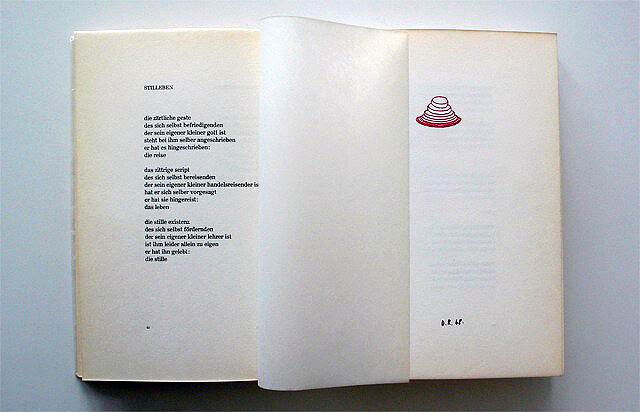Even for art audiences who are by now used to all kinds of dematerialized art objects—performers in lieu of objects or sets of instructions replacing lists of media—this exhibition of four artist-writers at Galerie Wien Lukatsch sets the bar high. It consists solely of recorded voices with no visual props whatsoever, posing a challenge to attention spans atrophied by the constant state of distraction that appears to be the new norm.
There is nothing to see here but the walls and windows, radiators and parquet floors of Wien Lukatsch’s third floor apartment gallery, barely furnished with folding metal chairs, tatami mats, and speakers. Stripped of visual distractions, each separate room—dedicated to a single artist reading texts aloud—feels more like a West Berlin doctor’s office than an exhibition space. But what kind of ailments could be treated here? Chronic synaesthesia? Terminal Fluxus Wortspiel? As the spoken words evaporate in the surrounding air, language seems almost impossible to grasp, and meaning even more so. Most apparent, however, was the pointed absence of the speakers themselves, all of whom passed away in the past forty years.
Born in 1928, 1930, 1943, and 1925 respectively, Arthur Köpcke, Dieter Roth, Tomas Schmit, and Emmett Williams were contemporaries, friends, and occasional collaborators. As such, this constellation of texts and voices suggests an oblique conversation of sorts, particularly when Williams reads one of Roth’s poems. Apart from this German rendition, however, Williams’s works are otherwise in English, a welcome relief from the spoken Deutsch of the other three participants, in which word-play can be hard to distinguish from words-proper for us non-native German speakers. Schmit’s convoluted prose-poems proved especially resistant to comprehension. What did he say? Schimmelamtspilzfuß?? Pilzamtsschimmelfuß? Fortunately, in Schmit’s room, printed texts are available that assist in interpretation—not that this necessarily helped in deciphering the meaning of these absurd, invented compound nouns.
Roth’s succinct and well-modulated poems are much easier to grasp. Reciting “mein Auge ist ein Mund [my eye is a mouth]”—a palindromic work which pivots at its center, reversing the meaning of each sentence and culminating with the line: “mein Mund ist ein Auge [my mouth is an eye]”—Roth’s sing-song voice modulates from down-up to up-down, using enunciation to sketch out the poem’s structural mirroring in space. Likewise, Williams’s colorful language suggests imaginary pictures akin to the textual configurations of his printed concrete poetry. This is literally so in the wonderful poem “Do you remember,” in which a handful of verbs, nouns, adjectives, and colors are swapped around line for line like a bag of penny sweets. Its final lines—“and you kissed livid yellow oysters / and I loved soft pink nights?”—hang palpably in the air like synaesthetic gumdrops. For Fluxus artist Köpcke, the oldest of the group, who died in 1977, the lengthy and dense conceptual composition “was ist das? [What is that?],” could only be partially understood, but the artist’s hypnotic, storytelling tones made it nonetheless compelling.
This exhibition asks that we reconsider the relationship between an artist’s works and their words. Williams is known first as a poet, and then as an artist; but for Roth, it is the other way around (a forthcoming exhibition focusing on Roth’s writing at the Kunstmuseum Stuttgart may shift that perception, however). In positioning their voices center stage, this show leads us straight to the artists’ writings in print, which, conveniently enough, can be found right here in Wien Lukatsch’s bookstore. Alongside a table of books and recordings by all four participating artists is a vitrine full of rare publications by Roth and others, including a 1968 edition of Roth’s Die gesamte Scheisse [The Complete Shit]. The chance to hold and read this rare material provides delayed relief from the visual deficit built into the exhibition itself.
As gallery, bookstore, and art book publisher combined, Wien Lukatsch is as committed to the printed word as it is to the discrete art object. “how to write III | artists read their texts” is the third installment of a series of thematic exhibitions focusing on “artists who write,” and is accompanied by a series of small, text-only publications with writings by gallery artists, such as Jimmie Durham and Haegue Yang, as well as Roth and Schmit. By emphasizing both facets of production in this series, Barbara Wien and Wilma Lukatsch suggest that taking either alone offers only a partial view of an artist’s work. But partiality is also the point here. After all, what could we possibly make of a prolific artist-writer like Köpcke when all we hear are a few minutes of his spoken words? Nevertheless, after spending an hour listening to these four artists’ recorded voices, my head was buzzing with tantalizing phrases—from “Amtspilzfußschimmel” to “livid red valleys”—and a nagging curiosity to see, and read, more.











